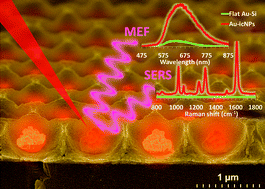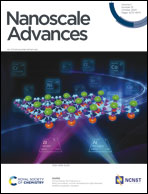Nano-substructured plasmonic pore arrays: a robust, low cost route to reproducible hierarchical structures extended across macroscopic dimensions†
Abstract
Plasmonic nanostructures are important across diverse applications from sensing to renewable energy. Periodic porous array structures are particularly attractive because such topography offers a means to encapsulate or capture solution phase species and combines both propagating and localised plasmonic modes offering versatile addressability. However, in analytical spectroscopic applications, periodic pore arrays have typically reported weaker plasmonic signal enhancement compared to particulate structures. This may be addressed by introducing additional nano-structuring into the array to promote plasmonic coupling that promotes electric field-enhancement, whilst retaining pore structure. Introducing nanoparticle structures into the pores is a useful means to promote such coupling. However, current approaches rely on either expensive top-down methods or on bottom-up methods that yield random particle placement and distribution. This report describes a low cost, top-down technique for preparation of nano-sub-structured plasmonic pore arrays in a highly reproducible manner that can be applied to build arrays extending over macroscopic areas of mm2 to cm2. The method exploits oxygen plasma etching, under controlled conditions, of the cavity encapsulated templating polystyrene (PS) spheres used to create the periodic array. Subsequent metal deposition leads to reproducible nano-structuring within the wells of the pore array, coined in-cavity nanoparticles (icNPs). This approach was demonstrated across periodic arrays with pore/sphere diameters ranging from 500 nm to 3 μm and reliably improved the plasmonic properties of the substrate across all array dimensions compared to analogous periodic arrays without the nano-structuring. The enhancement factors achieved for metal enhanced emission and surface enhanced Raman spectroscopy depended on the substrate dimensions, with the best performance achieved for nanostructured 2 μm diameter pore arrays, where a more than 104 improvement over Surface Enhanced Raman Spectroscopy (SERS) and 200-fold improvement over Metal Enhanced Fluorescence (MEF) were observed for these substrates compared with analogous unmodified pore arrays. The experiments were supported by Finite-Difference Time-Domain (FDTD) calculations used to simulate the electric field distribution as a function of pore nano-structuring.



 Please wait while we load your content...
Please wait while we load your content...